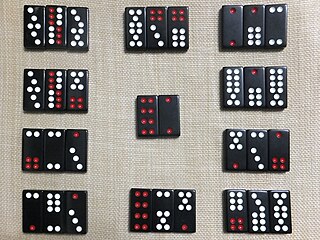
Chinese dominoes are used in several tile-based games, namely, tien gow, pai gow, tiu u and kap tai shap. In Cantonese they are called gwāt pái (骨牌), which literally means "bone tiles"; it is also the name of a northern Chinese game, where the rules are quite different from the southern Chinese version of tien gow.

Dominoes is a family of tile-based games played with gaming pieces. Each domino is a rectangular tile, usually with a line dividing its face into two square ends. Each end is marked with a number of spots or is blank. The backs of the tiles in a set are indistinguishable, either blank or having some common design. The gaming pieces make up a domino set, sometimes called a deck or pack. The traditional European domino set consists of 28 tiles, also known as pieces, bones, rocks, stones, men, cards or just dominoes, featuring all combinations of spot counts between zero and six. A domino set is a generic gaming device, similar to playing cards or dice, in that a variety of games can be played with a set. Another form of entertainment using domino pieces is the practice of domino toppling.
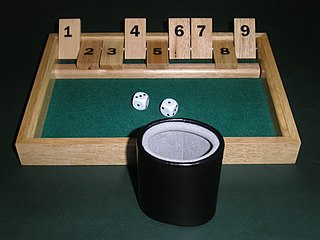
Shut the box is a game of dice for one or more players, commonly played in a group of two to four for stakes. Traditionally, a counting box is used with tiles numbered 1 to 9 where each can be covered with a hinged or sliding mechanism, though the game can be played with only a pair of dice, pen, and paper. Variations exist where the box has 10 or 12 tiles.

I.Q: Intelligent Qube, also known as Intelligent Qube in North America and Kurushi in Europe, is a 1997 puzzle video game developed by G-Artists and published by Sony Computer Entertainment for the PlayStation. In the game, the player controls a character who must run around a platform made of cubes, clearing certain cubes as they approach. Cubes are "cleared" by marking a spot on the stage, waiting for the cube to roll on top of it, and then deactivating the marked spot.
The Black Path Game is a two-player board game described and analysed in Winning Ways for your Mathematical Plays. It was invented by Larry Black in 1960.
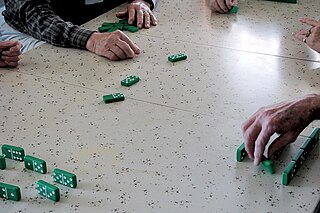
42, also known as Texas 42, is a trick-taking game played with a standard set of double six dominoes. 42 is often referred to as the "national game of Texas". Tournaments are held in many towns, and the State Championship tournament is held annually in Hallettsville, Texas on the first Saturday of March each year. In 2011 it was designated the official State Domino Game of Texas.

Domino Man is an arcade game released by Bally Midway in 1983. The player controls Domino Man, a bespectacled, balding man, wearing a beat-up turtleneck sweater and sporting a mustache, who attempts to set up a number of giant dominoes across the screen. The background music is "Maple Leaf Rag" by Scott Joplin.
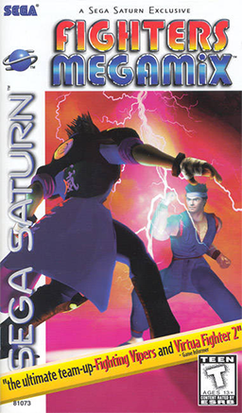
Fighters Megamix is a 1996 fighting game developed by Sega AM2, a crossover between Sega's 3D arcade fighting games Virtua Fighter 2 and Fighting Vipers, with unlockable characters from several other AM2 games such as Virtua Cop 2 and Daytona USA. Developed for Sega Saturn, it had a global release in 1997; unlike most of AM2's games of the era, Fighters Megamix did not have an arcade release.
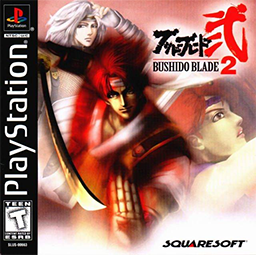
Bushido Blade 2 is a fighting video game published by Square, released in Japan and North America in 1998. It is the sequel to Bushido Blade, which had been released the previous year. The game was re-released in 2008 for PlayStation Network.
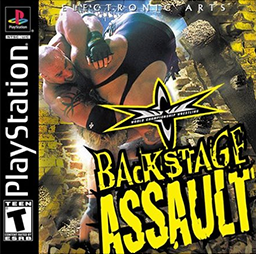
WCW Backstage Assault is a professional wrestling video game developed by Kodiak Interactive and published by Electronic Arts. It was released for the PlayStation in November 2000, and for the Nintendo 64 in December. It was the final World Championship Wrestling (WCW) game released before the World Wrestling Federation (WWF) purchased WCW's assets three months later. Backstage Assault features commentary by Tony Schiavone and Bobby "The Brain" Heenan. Gameplay takes place outside of a wrestling ring, an approach that was poorly received and resulted in the title selling 200,000 copies.

The Club is a third-person shooter video game developed by Bizarre Creations and published by Sega. It was released for PlayStation 3, Microsoft Windows, Xbox 360 and Mobile in February 2008. The story of the game centers on The Club, an underground blood sport controlled by a wealthy elite who place their bets on who will survive the gladiatorial-style combat. The game utilizes both racing and run-and-gun elements, where players must either complete a level quickly or defend a location from numerous enemy attacks for a set amount of time, all while accumulating their score through various kills with a bonus multiplier. It also includes eight multiplayer modes, featuring four-player local split screen or up to seven online. The Club received favorable reviews upon release.

G.A.S.P!! Fighters' NEXTream, known in North America as Deadly Arts, is a 1998 fighting game developed by Konami Computer Entertainment Osaka and published by Konami for the Nintendo 64. The story follows a series of fighters that have each received a mysterious letter to compete in a legendary contest, and about a champion that has disappeared. The story and the player profiles do not appear in the instructions for the North American version; except for the title, it is basically the same as the Japan and Europe versions, with slightly changed voice messages, and different character nameplates.

Magical Tetris Challenge is a 1998 puzzle video game by Capcom for the arcade, Nintendo 64, Game Boy Color, and PlayStation. It is a version of Tetris featuring Disney characters. It is one of the few Nintendo 64 games to be entirely in 2D, in addition to being Capcom's first game for the console. The Japanese arcade cabinet and cover art was done by Kenichi Sudo, while the North American cover art was done by Robert Griggs.

Muggins, sometimes also called All Fives, is a domino game played with any of the commonly available sets. Although suitable for up to four players, Muggins is described by John McLeod as "a good, quick two player game".

Mexican Train is a game played with dominoes. The object of the game is for a player to play all the tiles from his or her hand onto one or more chains, or trains, emanating from a central hub or "station". The game's most popular name comes from a special optional train that belongs to all players. However, the game can be played without the Mexican train; such variants are generally called "private trains" or "domino trains". It is related to the game Chicken Foot.

10000000 is a hybrid puzzle-role-playing game developed by Luca Redwood under the company name EightyEightGames, released initially for iOS in August 2012, and later for Windows and Mac via Steam in January 2013, and to Android and Linux systems in March 2013.

Q-Ball: Billiards Master, known in Japan as Dōkyū Billiard Master 2, and in Europe as Pool Master, is a video game developed by Ornith and published by ASK and Take-Two Interactive for the PlayStation 2 in 2000-2001. It is the sequel to the 1998 video game Pool Hustler, which was released for PlayStation.

The following is a glossary of terms used in dominoes. Besides the terms listed here, there are numerous regional or local slang terms. Terms in this glossary should not be game-specific, i.e. specific to one particular version of dominoes, but apply to a wide range of domino games. For glossaries that relate primarily to one game or family of similar games, see the relevant article.

Buki-Domino or Buki, is a gambling game that was widely played in Vienna in the early 20th century.



















